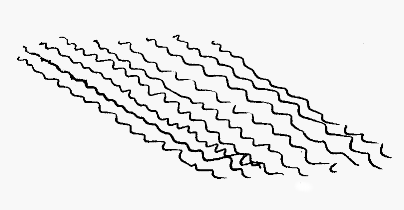
HITHER GATE MUSIC

HITHER GATE MUSIC
Goal: a descending, vibrating, flowing
wall of thin streams

Source: a single stroke on a Tibetan singing bowl bellae.wav (4.9 sec).
The first step is to soften the attack and make the ending of the sound more gradual. This is done with DOVETAIL, with 1 sec. of exponential curve (the rate of amplitude increase accelerates) at the beginning, and 1 second of linear slope (steady rate of decrease) at the end. The output is named bdtG5.wav.
The next step is to make it more supple by giving it a slow oscillation, moving between harmonic and inharmonic states – using STRANGE WAVER, we hear it get a bit tighter and thinner as it goes up. The rate of oscillation is 4 x per second (0.25), but a timestretch factor of 5 slows this down considerably. The lowest frequency affected is 50 Hz: bdtG5wavr.mp3.
Now we need to make this sound longer, so TIMESTRETCH the sound by a factor of times 2.3: bdtG5wavrstrx2&3.mp3. It is now 11 seconds long, and we have a nice long wavy filament.
The descending glissando aspect is achieved with STRANGE SHIFT, with which we push the sound upwards by 3000 Hz and have it gradually drop back down to its original frequency level over its 11 second duration. This uses a time value breakpoint file for the shift_factor:
Now the filament is a long, thin descending glissando: bdtG5wavrstrx2&3ss.mp3TIME VALUE 0 3000 11 5The desire to have the sound 'vibrate' leads us to further enhance this sound with a time-varying vibrato. So we start off with 1 vibrato per second and end with 30 per second. This information is provided in another breakpoint file for the vibrato_factor:
This is the result: bdtG5wavrstrx2&3ssvib.mp3. This final enhancement is judged to provide a sufficient basis for creating a flowing wall/curtain/veil of these filaments, so we move on to Stage 2.TIME VALUE 0 1 11 30
The plan is to use TEXTURE SIMPLE, mode 3 to pack these filaments closer together: 0.1 sec apart, with a 0.05 timing offset. The richness of the texture is further improved by providing a 3-pitch harmonic set: D-F-G. This means that each of the note events, spaced at ca. 1/10th of a second, will be randomly placed on either D, F or G above Middle C. At such a close temporal spacing, this means that there will be a 3-note chord of descending glissandos.
Now we have reached our goal of a descending, vibrating wall of sound: tz5s2tex3.mp3, used for the 2nd section of the 5th Tzolkin cycle.